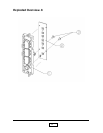
HD DVD (high-definition DVD) A next-generation
optical disc format developed for high-definition
video recording and rewriting. Types (red or blue
laser) and storage capacity of HD DVDs vary.
They include blue-laser DVD and Blu-ray disc.
HDMI (high-definition multimedia interface)
An uncompressed, all-digital audio/video interface
between any compatible digital audio/video source,
such as a set-top box, DVD player, and A/V receiver,
and a compatible digital audio and/or video monitor,
such as a digital television (DTV). HDMI supports
standard, enhanced, or high-definition video, plus
multi-channel digital audio on a single cable, and
is backward-compatible with DVI.
HDCP (high-definition content protection) An
encryption in high-definition signals that prevents
unlawful duplication. HP’s HD demo tapes have
HDCP encoded.
HDTV ATSC tuner An internal or external over-
the-air tuner that receives high-definition television
signals. Also called “ATSC HD tuner.”
I
Integrated HD An HDTV that has a built-in
high-definition receiver/tuner.
Interlaced (i) scanning A method of displaying
images from a video signal on a TV screen by filling
in every other line (the odd lines), and then filling
in the other lines (the even lines), so only half of the
set’s lines are “firing” at a given time. Interlacing
allows for greater resolution at lower bandwidth,
but it can produce flicker if you’re watching sports
or other content showing rapid movement.
J-K-L
Low-angle interpolation A corrective feature in HP
TVs that smoothes out the “staircase effect” caused
by viewing at certain angles.
Lumen The unit used for measuring light output,
expressed in “candelas per square meter,” or cd/m².
M
Microdisplay TV A large-screen television using
rear projection technology. The newest generation
of microdisplay TVs are more lightweight and
compact than are their earlier counterparts.
Motion adaptive de-interlacing Detects and
compensates for motion in pictures, reducing
contours and greatly diminishing visual noise
without reducing picture detail.
N-O
Optical cable A digital connector that carries
information optically rather than electronically, which
renders it unsusceptible to electrical interference.
Over-the-air HD programming Requires TV owners
to have an HD antenna and HD-capable TV, and
live in an area where digital television is broadcast.
P
Personal video recorder A device that can record
and play back television in digital format, as
opposed to the analog format recorded by a VCR.
Also called “digital video recorder.”
PIP (picture in picture) A television feature that
allows you to view multiple TV channels
simultaneously by creating one or more smaller
displays within the larger television display.
POP (picture outside picture) A television feature
that allows you to view two or more (depending
on the type of POP capability the set has) TV
channels simultaneously by dividing the television
display into halves.
Progressive (p) scanning A method of displaying
images from a video signal on a TV screen by
filling in all of the vertical lines sequentially, rather
than in two passes, as with interlaced scanning.
Glossary continued


















